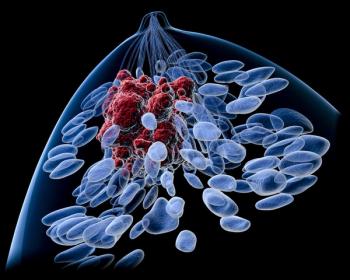
Camizestrant/Ribociclib Improves PFS and Responses in ER+/HER2– Breast Cancer
Patients with ER+/HER2– advanced breast cancer saw positive efficacy and safety data following treatment from the SERENA-1 trial.
Results from the multicenter, first-in-human phase 1 SERENA-1 trial (NCT03616587) presented at the
Specifically, the presentation featured parts of the study examining the safety and efficacy of 75 milligrams (mg) of camizestrant daily with either 400 or 600 mg of ribociclib administered for 21 days on and 7 days off.
As of a data cut-off of September 16, 2024, 60 patients had received the combination, with 22 still receiving therapy, and with the median duration of treatment being 7.5 months (range, 0-13) in the 400 mg of ribociclib arm and 5.6 months (range, 0-13) in the 600 mg of ribociclib arm.
The median progression-free survival (PFS) was 8.1 months (95% CI, 1.9-NE) in the 400 mg arm and 8.1 (95% CI, 2.0-NE) months in the 600 mg arm, while the objective response rate (ORR) with measurable or non-measurable disease at baseline was 11.1% (3/27) in the 400 mg arm and 12.5% (4/32) in the 600 mg arm.
CBR24 — defined by researchers as the percentage of patients who have the best objective response of complete response (CR) or partial response (PR) in the first 25 weeks or who have stable disease (SD) for at least 23 weeks after the start of treatment — was 55.6% (15/27) in the 400 mg arm and 53.1% (17/32) in the 600 mg arm.
CBR24 rates were 55.6% and 47.6% among patients who had received prior fulvestrant (Faslodex), 56.0% and 53.1% among patients who had received a prior CDK4/6 inhibitor (CDK4/6i), and 56.3% and 66.7% among patients in whom an ESR1 mutation was detected.
Patients’ median ages were 58 years (range, 31-81) in the 400 mg arm and 55 years (range, 37-80) in the 600 mg arm, while 86% and 84% were post-menopausal, respectively. Patients in both groups had received a median of 2 prior regimens (ranges, 0-4 and 1-6, respectively) in the advanced setting and a median of 2 prior endocrine regimens (ranges, 0-3 and 0-5) in the advanced setting, and 0 (range, 0-1) and 1 (range, 0-2) median chemotherapy regimens in the advanced setting. Most patients had received prior treatment with fulvestrant in an advanced setting (61% and 66%) and prior treatment with a CDK4/6i in an advanced setting (89% and 100%), while 57% and 38% of patients, respectively, had an ESR1 mutation detected.
Adverse events of any grade reported in at least 20% of patients included neutropenia (32.1% in the 400 mg arm, 53.1% in the 600 mg arm), nausea (39.3%, 46.9%), photopsia (39.3%, 34.4%), and sinus bradycardia (39.3%, 31.3%). The most common grade 3 or higher adverse event was neutropenia (10.7%, 43.8%).
“Camizestrant 75 mg in combination with either ribociclib 400 mg or 600 mg was well tolerated; the safety profile of camizestrant 75 mg when dosed with ribociclib is comparable to that of camizestrant 75 mg monotherapy, and that of camizestrant 75 mg dosed with other CDK4/6i (abemaciclib [Verzenio] and palbociclib [Ibrance]),” researchers noted in a poster presentation of the findings.
Researchers further stated that, despite extensive prior lines of therapy, encouraging clinical activity was observed for camizestrant 75 mg in combination with either ribociclib 400 mg or 600 mg.
Reference
Ruiz-Borrego M, Ruiz IV, Vaklavas C, et al., Results from SERENA-1 Parts K/L: A Phase 1 study of the next-generation oral selective estrogen receptor degrader (SERD) camizestrant (AZD9833) in combination with ribociclib in women with ER-positive, HER2 negative advanced breast cancer, presented at the San Antonio Breast Cancer Symposium, December 10-13, 2024, San Antonio, Texas. PS7-08.
Newsletter
Stay up to date on recent advances in the multidisciplinary approach to cancer.

















































































